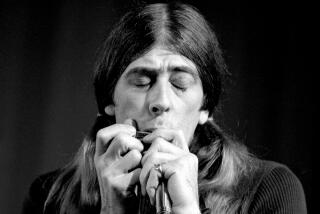Guy Webster, whose photos ruled the world of album covers, dies at 79
Guy Webster, a self-trained photographer who helped shape the late 1960s music scene with album covers that became as familiar as the songs they held, has died at his home in Ojai.
In demand by musicians and celebrities throughout his life, Webster died Feb. 5 at the age of 79. His death was not publicly announced at the time. The cause was liver cancer, said rock historian Harvey Kubernik, who was Webster’s biographer.
Webster was an under-recognized star during a musical era when album covers were part of the visceral experience of record-buying. His was the moody lakeside shot of the Rolling Stones used on the cover of “Big Hits (High Tide and Green Grass)” and the unsettling photo of Paul Simon and Art Garfunkel looking over their shoulders as they hurry down a dirt path on “Sounds of Silence.” The Doors, the Byrds, the Mamas and the Papas, the Turtles, Procol Harum, Carole King, Nico — his photos stood as a gateway to the sounds of the ’60s and early ’70s.
Kubernik, who with his brother Kenneth wrote “Big Shots: The Photography of Guy Webster,” said he first noticed Webster when he was 14 and took a chunk of his bar mitzvah money to buy an armload of records. As he looked them over, he noticed a commonality: Most of the photos used on the album covers had been shot by Webster.
“You’d cradle the cover, read the notes on the sleeve and listen to the music,” he said. “His images captured the music, they were part of the music.”
Born Sept. 14, 1939, Webster grew up in Beverly Hills in a home filled with music. His father, Paul Francis Webster, was a renowned lyricist who won three Academy Awards and Webster said he recalled seeing megastars such as Ella Fitzgerald, Frank Sinatra and Duke Ellington drift through their house.
His parents saw Ivy League potential in their son. He saw a different future and went off to Whittier College and the ArtCenter College of Design in Pasadena instead. But it wasn’t until a stint in the military that he was introduced to photography. A conscientious objector, he said he refused to handle a weapon. Exacerbated, his sergeant at what was then Ft. Ord eventually assigned him to teach recruits how to handle a camera. Knowing little about photography, he hurriedly read a few books on photography to get up to speed.
A chance meeting on a basketball court with producer Lou Adler led to a job as the house photographer for Dunhill Records, then a fledgling label with just one client, protest singer Barry McGuire. When Adler went on to help pull together the Monterey Pop Festival, Webster tagged along and shot pictures of a just-emerging Jimi Hendrix and the Who, with Pete Townshend smashing his guitar to splinters. As his portfolio grew, so did his reputation among artists and their managers.
In 1966, as the L.A. music scene was taking root, Webster met up with the members of the Mamas and Papas at a rented house in West Hollywood, where the group was holed up waiting for fame to find them.
The house was thick with smoke and the band members were so stoned they could barely stand, Webster said in an interview with Harvey Kubernik.
“We gotta shoot something,” Webster recalled saying, before hitting on the idea of positioning them in a bathtub — Denny Doherty, Cass Elliot and John Phillips, with Michelle Phillips sprawled over her bandmates.
There was one complication, however. The bathroom’s toilet was clearly visible and Adler worried that the large department stores — a marketplace for albums sales at the time — would balk at allowing the album to be displayed. So Adler and Webster came up with a clever solution: putting a small sticker on the shrink-wrap that said “Including ‘California Dreaming.’”
“And that covered the toilet,” Webster said. “Kid opens it up and there it is.”
The cover photo for “High Tide and Green Grass,” which seems to capture the grayness of the English countryside, was shot in Franklin Canyon in Los Angeles. The “Sounds of Silence” photo for Simon and Garfunkel was shot in L.A., too, capturing a pair of New Yorkers in the Hollywood Hills. The cover for the Doors’ debut album, with Jim Morrison’s face dominating the frame, was shot in a small studio at Webster’s parents’ house.
“Guy never planned this career,” Kubernik said. “Believe me, there was no handbook for the ’60s.”
But by 1971, he’d had enough. He’d shot over 200 album covers, gone on tours with the Mamas and the Papas and the Beach Boys and increasingly was in demand in Hollywood. He told Kubernik he was fed up with the Nixon administration, the war in Vietnam and the direction the country was headed. He also was put off by the increasingly corporate structure of the record industry, in which agents and executives second-guessed his creative impulses.
So he moved to Spain and then to Italy, where he studied art and became enamored with Italian motorcycles.
Before he left California, he bumped into Morrison, whom he’d known since college. The musician was bearded, overweight, hardly recognizable. Two months later, he was dead. In Spain he bumped into Nico, the former frontwoman for the Velvet Underground, whom he’d photographed for a solo album. She approached him at a bar and asked if he had any drugs. When he said no, she wandered away. Before long, she too was dead.
After half a decade abroad, he returned to California and resumed his photography career, shooting Hollywood celebrities, authors, musicians, U.S. presidents, too — among them actor Dennis Hopper and President Reagan. He also opened a studio in Venice.
Photography had been kind to Webster.
“Within one year, I was making money,” he told The Times in 2017. “Within two years, I was rich. I was a celebrity.”
He bought a house in Beverly Hills, another on Martha’s Vineyard and a ranch in Ojai, where he stored his massive collection of motorcycles. He said it was likely the best collection of Italian motorcycles in the Unites States, worth as much as $5 million. Occasionally, he would open his private collection to visitors and motorcycle buffs.
But a debilitating stroke in 2015 left him unable to move his left arm and leg. Unable to ride his motorcycles anymore, he sold them off, one by one.
Kubernik said while Webster was aware of his contributions to the music world of the ’60s, he never worried about what his legacy might be.
“But he did understand the lasting durability of music.”
Webster is survived by his wife, Leone, daughters Erin, Sarah, Jessie and Merry, son Michael, two grandchildren and a brother, Roger. His first marriage, to Bettie Beal, ended in divorce.
Twitter: @stephenmarble
Twitter: @stephenmarble
More to Read
Start your day right
Sign up for Essential California for the L.A. Times biggest news, features and recommendations in your inbox six days a week.
You may occasionally receive promotional content from the Los Angeles Times.







